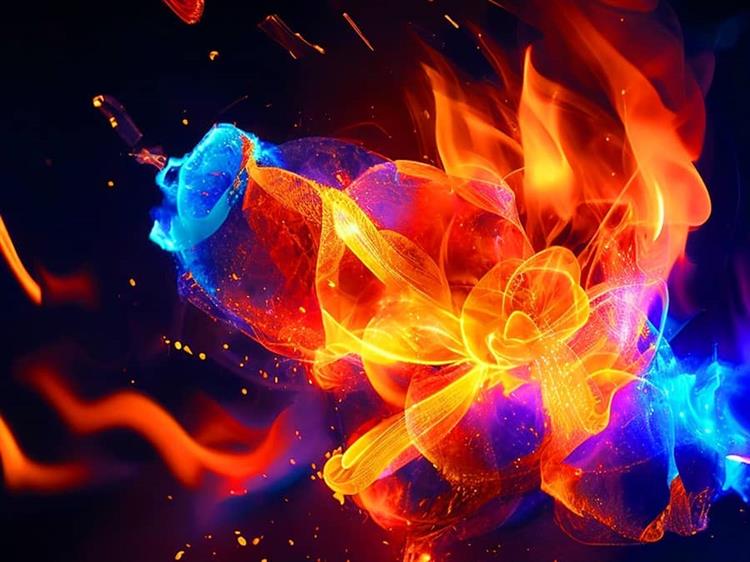
- 04 April 2024
- 1983 Views
Brief Overview: The Science Behind Flame Colors
The captivating dance of colors in flames—from the deep blue of a gas burner to the bright yellow of a campfire—is a phenomenon governed by the principles of chemistry and physics. The color emitted by a flame is primarily influenced by two factors: the temperature at which the material burns and the chemical composition of the material itself. Higher temperatures result in flames that lean towards the blue spectrum, indicating a more efficient combustion process. In contrast, lower temperatures yield red or orange flames, often seen in less intense combustion.
Certain chemical elements, when heated, emit specific colors. This is due to the excitation of electrons in the atoms; when these excited electrons return to their ground state, they release energy in the form of light. The wavelength (and thus the color) of this light depends on the specific energy changes associated with the chemical element involved. This principle is not only a fascinating aspect of natural science but also finds practical applications in fields ranging from safety and environmental monitoring to pyrotechnics and art.
The Chemistry of Fire
At its core, fire is a chemical reaction known as combustion, involving fuel, oxygen from the air, and heat. This reaction releases energy in the form of light and heat, manifesting as flames. The colors of these flames are primarily determined by two factors: the temperature of the fire and the presence of specific elements or compounds within the flame.
| Factor | Influence on Flame Color | Typical Colors | Examples/Notes |
|---|---|---|---|
| Temperature | Higher temperatures produce blue flames; lower temperatures result in red or orange flames. | Blue, Red, Orange | Blue flames in gas stoves and Bunsen burners indicate efficient combustion. |
| Chemical Composition | Specific chemicals emit unique colors due to electron movements. | Varies | Copper for green, sodium for yellow, potassium for purple. |
| Presence of Soot | Incomplete combustion creates soot, glowing yellow or orange. | Yellow, Orange | Candle flames and campfires often show yellow or orange due to incandescent soot particles. |
The Spectrum of Fire: From Blue to Red
The color of a flame is directly linked to its temperature, governed by Wien's displacement law. In simpler terms, the hotter the flame, the closer its color shifts towards the blue end of the spectrum, and conversely, cooler flames appear red or orange. This temperature-dependent behavior is why a gas stove's flame is blue, indicating a hotter and more efficient combustion process, whereas a campfire, burning at a lower temperature, glows with a warm orange hue.
Blue Flames: Indicators of High Heat
Blue flames are the hallmark of complete combustion, where the fuel is fully consumed, producing maximum heat. Methane gas, when ignited, burns with a clean blue flame, reaching temperatures upwards of 1,400°C (2,552°F). This efficiency and high heat make blue-flame combustion desirable in industrial applications and cooking.
Yellow and Orange Flames: The Role of Soot
The iconic yellow or orange glow of a candle flame or campfire is due to incomplete combustion. In these scenarios, the combustion process leaves behind tiny carbon particles (soot), which become incandescent and emit light in the warmer colors of the spectrum. These flames are cooler, burning at around 1,000°C (1,832°F).
Green, Purple, and Beyond: The Influence of Elements
Beyond the reds and blues, flames can exhibit an array of colors depending on the chemical elements present. For example, copper compounds produce a striking green flame, while potassium yields a lilac color. These principles are applied in pyrotechnics to create the dazzling colors seen in fireworks.
Environmental and Practical Implications
Understanding flame color is crucial in various fields, from safety and environmental monitoring to artistic and culinary applications. For instance, a sudden shift in flame color in industrial settings can signal incomplete combustion or the presence of hazardous chemicals, prompting immediate corrective action.
The Art and Science of Flame Colors
The manipulation of flame color has found its place in art and culture. Glassblowing, metalworking, and even culinary presentations utilize the knowledge of chemical compounds to achieve desired aesthetic effects. In scientific education, flame tests serve as a vivid method to demonstrate the presence of specific elements, turning a simple experiment into a display of colorful fireworks.
Conclusion
The colors of fire are more than just a visual spectacle; they are a window into the complex world of chemical reactions and physical principles. From the deep blue of a gas burner to the vibrant greens and purples of fireworks, each color tells a story of temperature, combustion, and elemental composition. Understanding these colors not only enriches our appreciation of this natural phenomenon but also enhances our ability to harness and respect the power of fire in our daily lives.
